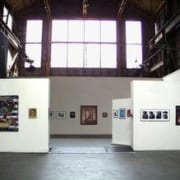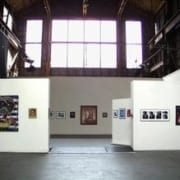Review of FACE by Jeffrey Wilson
The Queer Cultural Centers FACEs
at SOMAR Gallery, June 11 – 27, 1998
by Jeffrey Wilson
Recent events have caused me to reflect on an old joke from way back in the early 1990’s that was circulating around the “art world” in the wake of the first political attacks on the NEA and its funding of so-called “homo-erotic art.” It went something like, “Did you hear that Phillip Morris was planning to build a Jesse Helms Memorial Museum in North Carolina, but they had to cancel it because they couldn’t find any art in it?”
The point, of course, was that Mr. Helms wasn’t likely to approve of what today’s artists are making–especially given the fact that something like 98 percent of all the really good art made in America since the 1950s has been made by subversive, “socially undesirable” types like us queers. The really sad part of the joke–and the reason it wasn’t funny in the first place–was that Jesse’s delicate sensibilities were being taken very seriously on the Senate floor; and, laugh all we want, the truth was that queer artists were going to have to be more closeted if they still wanted to get money from the government.
I refer to this joke because I actually met two NEA funding officers this week, at the closing night of Theatre Rhinoceros’ recent smash hit, Up Jumped Spingtime, which was about the lives of young, gay, African-American men. They seemed to genuinely like the show, but they also seemed surprised by how much the audience really LOVED the show, and how much the audience was relating to it, and getting out of it (I guess the two of them were straight, duh).
They also got me to thinking when I went to see the new FACE show at SOMAR Gallery this week, which is the inaugural exhibit of the Queer Arts Festival currently running here in San Francisco through mid-July. Subtitled “An Exhibition of Queer Expression through Self-Portraiture,” the FACE show consists of 80 self-portraits by 51 local queer visual artists working in the mediums of painting, photography, sculpture, and mixed-media collage.
I was thinking about “the joke” because I was looking at 80 images by queer people who were making art based on themselves, and therefore setting the terms of their own “queer visibility.” Given the context of queer history in U.S. society, this has obvious political weight–both in reaction to our traditional place in the shadows of anonymity, and our current tendency to grab every light source in the vicinity in order to show the world that we exist. And I was thinking about the invisible lines between art and politics, and trying to imagine how looking at a bunch of queer faces might be different if, say, I were a heterosexual funding officer working for the NEA. But most of all, I was thinking about “the joke” because so many of those 80-odd images were actually quite beautiful and interesting, and how many museums and galleries around the country would be proud to have them–except, of course, for Jesse’s.
The work that first drew my attention was a large painting by Douglas Johnsonson entitled, “Irrational Inquiry,” which by way of its size, theme, and central placement in the gallery seemed almost to function as a fulcrum for the rest of the show. In it, a male figure representing the artist is sitting in a little Greek-looking temple (as in, “my body is a”), and studying himself in two hand mirrors. Using terracotta tones and a style of figure drawing I would guess to be more Roman than Greek, Johnsonson offers a timeless portrait of the artist in self-reflective meditation. “Irrational Inquiry” is also flanked by three, simpler self-portraits by Johnsonson, which are technically well rendered, but come across as unremarkable next to the larger, more conceptual canvas.
Two other striking images of an artist studying herself are offered by painter Sandra Yagi, entitled “Bosch For The Millennium,” and “Untitled #3.” Unlike Johnsonson, however, Yagi is much more successful in the simpler painting, “Untitled #3,” which features the artist sitting in front of a vanity mirror, in the act of placing a mask over her face. On the vanity are three additional masks, implying, of course, that she is in the process of choosing which mask to wear, or, perhaps, which face to present to the world that day. As a queer artist in a queer show, the further implication is that one’s face is a self-conscious, self-representational strategy that we queers have to be particularly careful to construct in a hetero-dominated world.
Happily, several of the artists in the show approach this process of “facial construction” with whimsical defiance, which, of course, is what drag queens have been doing since a couple of days after the dawn of time. In fact, the first four paintings on encounters upon entering the gallery are a sort of “fantasy drag” sequence by Steven Elliot — full of bright colors, mythical creatures, and Disney characters–but also laced with a certain bitterness about the real world which we inhabit. In Elliot’s “Nothing Sadder,” we see the artist casting himself into a role closely resembling the evil, aging queen from Sleeping Beauty, surrounded by the annoyingly perky likes of Peter Pan, Cinderella, Jiminy Cricket, and my favorite, Pinocchio, who is reading book by Oscar Wilde and looking confused. All over the canvas are little reminders that the evil queen (and by extension, all of us who aren’t getting any younger) are living in a culture obsessed by youth–the most blatant of which is a little royal text-ribbon snaking across her arm that reads, “youth, youth, there is nothing in the world but youth.”
There are several other examples in FACE of artists humorously casting themselves into icons and roles, including Clover Leary and Noah Webb’s “Movie Poster Series”–which are four large prints that are made to look like ’50s-era Hollywood posters for campy sci-fi films–in which Leary and Webb play the leading lady and man (the best is for Galaxy Scenes, where they are body-painted to look like silver martians). And yes, given the context of the show, it’s impossible not to read these as commentary on the traditional queer invisibility in Hollywood films–especially since it looks suspiciously as if Leary and Webb are going to play heterosexuals in the films (like Rock Hudson & Marlene Dietrich, perhaps?)
But putting whimsy and sociopolitical statements aside, the majority of the self-portraits in FACE seem to suggest vulnerability, and even an unsureness about how we really are–as individuals and as a “community.” These come in several varieties and categories; my favorite category being the familiar “look art me–naked, proud, and human–imperfect but still beautiful” type of art. Tops in this category goes to Morgan Caulfield’s photograph of her nude, 50-something, strong-looking body; face obscured by a tilted sun hat, and featuring really saggy tits. More delicate but even more intriguing is Maxine Kincora’s “Fragments,” a multi-level, three dimensional collage of her body pieced together from two photos–one of which is taken naked and in black and white, the other in color wearing a silky red slip.
Several of the male artists in the room expressed this kind of vulnerability through the slightly hacked medium of a shadowy black and white photograph that captures the man, naked and alone in his natural surroundings, with a flacid penis for all to see. However, most adopted a fresher, more sophisticated approach–including conceptual elements and strong use of graphics and text. I couldn’t help but be disturbed by the mixed message of Don Garlow’s “The Accident,” in which the handsome, unclothed artist seems proud to display the underside of his wrists, which have been recently slashed and stitched (it doesn’t look like an accident to me). My personal favorite San Francisco painter, Timothy Cummings, offers one of his characteristic harlequin-style self-portraits, in which the arms and legs are curiously missing and the chest has been sliced open to reveal the machinery inside the cavity–which actually looks like the inside of a clock. Very clever, very sensitive boy, that Timothy.
As I came away from the show, it occurred to me that what both the exhibition curators, Rudy Lemcke and Lenore Chinn, as well as the 50 artists themselves, were showing me was actually something about modern queer identity in transition. Almost as if, now that our masks and invisibility have been largely left in the past, we are seeing how different we all are, and yet, still tied together by something as invisible as a communal hunger to get to the next level of empowerment.
I felt this most clearly when thinking about a cryptic collage by William Ulrich, in which hints of the man and his memories are present, but I couldn’t quite find the man himself. There was, however, a little poem in the corner of the piece, which resonated even beyond Ulrich”s own story to something I was feeling from the rest of the show. It read “I have buried the man I used to be, along with his hopes and dreams for the future. Now I walk by him every day, as if I were passing the grave of a stranger.”
Poor Jesse Helms, I know he’d never understand it.Color




